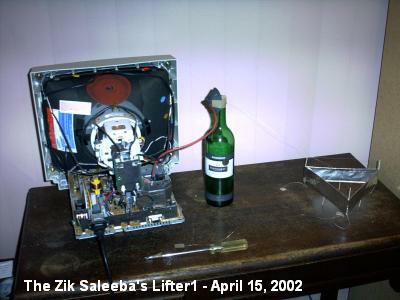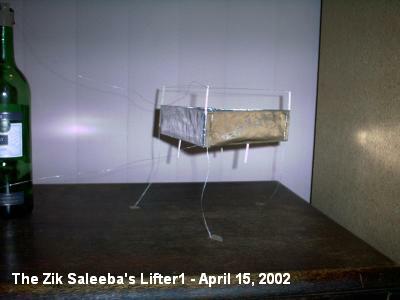
A
Successful Lifter1 experiment
by
Zik Saleeba ( Melbourne, Australia )
created on
April 15, 2002 - JLN Labs -
Last update April 18, 2002
All informations in this page are published free and
are intended for private/educational purposes and not for
commercial applications
|
Hi Jean-Louis,
I've successfully replicated the Lifter1 - thanks for your
instructional web pages! I've put together a web page at http://www.zikzak.com.au/zik/lifter/
describing my experiences. Feel free to reproduce the photos from
there if you like. There's also a rather poor quality MPEG video.
Next I'm going to look at making a lightweight AC power supply
suitable for use with a flying model. I'm also interested in
trying to detect mass loss or positive charging in a closed
system to attempt to verify that electrons are acting as reaction
mass.
Zik Saleeba
Melbourne, Australia

Instructions on how it was built are given at "How to build and replicate yourself the Lifter1 Experiment". Many thanks to Jean-Louis Naudin for all the effort he's put into his web site. The separation between anode and cathode was set at 27.5mm for this experiment, which may have been a little low for the 50% humidity conditions at the time since some arcing was experienced during the runs.
It really is as simple as it looks, by the way. It's just a light balsa wood frame with a wire around the top and some alfoil around the bottom. I carefully rounded the top edge of the foil part since this is meant to improve performance. Total weight was under 10g, lower than I could accurately measure with the scales I had on hand.
The apparatus is pretty simple. The electronic device on the left is an old computer monitor. I've taken the high-tension line off the CRT for use as a 27.5kV DC power supply. The wine bottle is just a support for the high tension line so it doesn't get tangled with the earth line. Believe me it sizzles nastily when that happens ;)
The lifter is attached to the table with three short tethers - in my case short lengths of dental floss. These tethers are just to prevent the thing going crazy, flying out of the room and terrorising the neighborhood :) Or at least to stop it zooming upward and getting its wires in a tangle.
High voltages are bad. Despite being very cautious, I managed to make many long sparks in the course of this experiment. I strongly recommend that you understand high voltage safety before attempting this experiment yourself.
So what happens when you turn the power on?

As soon as the power was switched on the device lifted straight off the table. It moved very quickly, accelerating until it hit the end of its tethers. It lurched drunkenly around at the top of its travel for a couple of seconds until it sparked brightly on the left hand side and I switched it back off.
The performance of the lifter was impressive. There's no doubt that a strong thrust was being produced - it lifted very rapidly and would have kept going except for the tethers holding it down. Making a thruster strong enough to carry its own power supply would be difficult, but if it could be achieved the device would just keep heading up until it ran out of power - if it didn't run out of power it would presumably keep going until it escaped Earth's gravity entirely and started accelerating off into space at greater than 1g acceleration.
For more info, visit the Zik's web site at : http://www.zikzak.com.au/zik/lifter/
See also the :
 Lifters builders
and tests feed-back
Lifters builders
and tests feed-back ![]()
Return to the Lifters Builders page